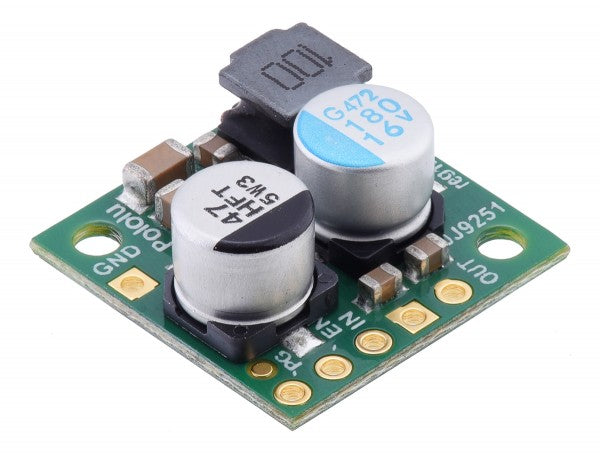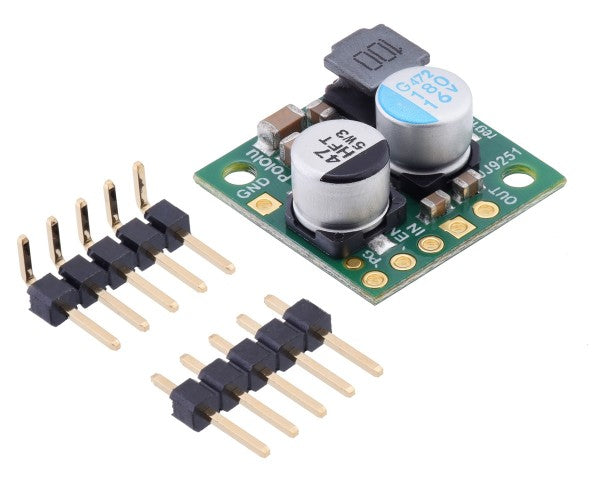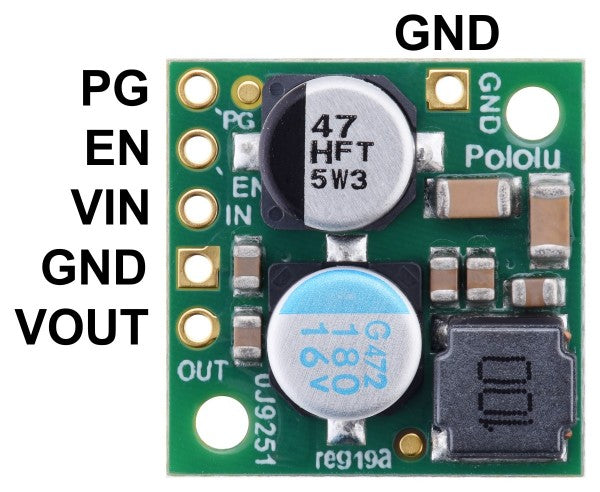Beschreibung
This small synchronous switching step-down (or buck) regulator takes an input voltage of up to 36 V and efficiently reduces it to 12 V. The board measures only 0.7? × 0.7? yet delivers a typical continuous output current of up to 2.2 A and features reverse voltage protection. Typical efficiencies of 90% to 95% make this regulator well suited for powering moderate loads like sensors or small motors. An optional shutdown pin enables a low-power state with a current draw of around 50 ?A to 350 ?A, depending on the input voltage, and a power-good output indicates when the regulator cannot adequately maintain the output voltage.
The D24V22F12 step-down voltage regulator generates lower output voltages from input voltages as high as 36 V. It is a synchronous switching regulator (also called a switched-mode power supply (SMPS) or DC-to-DC converter) with typical efficiencies of 90% to 95%, which is much more efficient than linear voltage regulators, especially when the difference between the input and output voltage is large. The available output current is a function of the input voltage and efficiency (see the Typical efficiency and output current section below), but the output current can typically be as high as 2.2 A.
These regulators have a typical quiescent (no load) current draw of around 1 mA, and an enable pin can be used to put the boards in a low-power state that reduces the quiescent current to approximately 5 µA to 10 µA per volt on VIN.
The modules have built-in reverse-voltage protection, short-circuit protection, a thermal shutdown feature that helps prevent damage from overheating, and a soft-start feature that reduces inrush current.
Features
- Supports input voltages up to 36 V
- Fixed 12 V output with 4% accuracy
- Typical maximum continuous output current: 2.2 A
- Typical efficiency of 90% to 95%, depending on input voltage and load
- Dropout voltage ranges from ~0.6 V at no load to ~1.1 V at 2.2 A (see below for more information on dropout voltage)
- Switching frequency: ~400 kHz
- Integrated reverse-voltage protection, over-current protection, over-temperature shutoff, and soft-start
- 1 mA typical no-load quiescent current; this can be reduced to approximately 5 µA to 10 µA per volt on VIN by disabling the board
- ?Power good? output indicates when the regulator cannot adequately maintain the output voltage
- Compact size: 0.7? × 0.7? × 0.31? (17.8 mm × 17.8 mm × 8 mm)
- Two 0.086? mounting holes for #2 or M2 screws
Other voltage versions
We expect to release other voltage versions of this regulator in November 2015. Until then, the closest substitutes are the similar D24V25Fx family of step-down voltage regulators:
- 3.3V, 2.5A Step-Down Voltage Regulator D24V25F3
- 5V, 2.5A Step-Down Voltage Regulator D24V25F5
- 6V, 2.5A Step-Down Voltage Regulator D24V25F6
- 7.5V, 2.5A Step-Down Voltage Regulator D24V25F7
- 9V, 2.5A Step-Down Voltage Regulator D24V25F9
These regulators are the same size as the D24V22F12 and they have similar current capabilities and input voltage ranges, but they do not have the same pinout and they are based on a different internal design, so there are fundamental differences in operation.
Using the regulator
Connections
This buck regulator has five main connection points for five different electrical nodes: power good (PG), enable (EN), input voltage (VIN), ground (GND), and output voltage (VOUT). The board also features a second ground connection point off the main row of connections that might be convenient for applications where you are soldering wires directly to the board rather than using it in a breadboard.
 |
The input voltage, VIN, powers the regulator. Voltages up to 36 V can be applied to VIN. The effective lower limit of VIN is 12 V plus the regulator?s dropout voltage, which varies approximately linearly with the load (see below for a graph of dropout voltages as a function of the load).
The output voltage, VOUT, is fixed at 12 V.
The regulator is enabled by default: a 270 k? pull-up resistor on the board connects the EN pin to reverse-protected VIN. The EN pin can be driven low (under 1 V) to put the board into a low-power state. The quiescent current draw in this sleep mode is dominated by the current in the pull-up resistor from EN to VIN and by the reverse-voltage protection circuit, which altogether will draw between 5 µA and 10 µA per volt on VIN when EN is held low (~50 ?A at 13 V in to ~350 ?A at 36 V in). If you do not need this feature, you should leave the EN pin disconnected.
The ?power good? indicator, PG, is an open-drain output that goes low when the regulator?s output voltage falls below around 10 V and becomes high-impedance when the output voltage rises above around 11 V. An external pull-up resistor is required to use this pin.
|
|
The five main connection points are labeled on the top of the PCB and are arranged with a 0.1? spacing for compatibility with solderless breadboards, connectors, and other prototyping arrangements that use a 0.1? grid. Either the included 5×1 straight male header strip or the 5×1 right angle male header strip can be soldered into these holes. For the most compact installation, you can solder wires directly to the board.
 |
| Pololu 12V, 2.2A Step-Down Voltage Regulator D24V22F12, side view. |
|---|
The board has two 0.086? (2.18 mm) diameter mounting holes intended for #2 or M2 screws. The mounting holes are at opposite corners of the board and are separated by 0.52? (13.21 mm) both horizontally and vertically.
Typical efficiency and output current
The efficiency of a voltage regulator, defined as (Power out)/(Power in), is an important measure of its performance, especially when battery life or heat are concerns. As shown in the graph below, this switching regulator typically has an efficiency of 90% to 95%:
 |
The maximum achievable continuous output current is typically around 2.2 A, but this depends on many factors, including the ambient temperature, air flow, heat sinking, and the input and output voltage.
During normal operation, this product can get hot enough to burn you. Take care when handling this product or other components connected to it.
Typical dropout voltage
The dropout voltage of a step-down regulator is the minimum amount by which the input voltage must exceed the regulator?s target output voltage in order to ensure the target output can be achieved. For example, if a 12 V regulator has a 1 V dropout voltage, the input must be at least 13 V to ensure the output is the full 12 V. As shown in the graph below, the dropout voltage increases approximately linearly as the output current increases.
 |
Verschlüsselte Zahlung
Ihre Zahlungsinformationen werden sicher verarbeitet. Wir speichern keine Kreditkartendaten und haben auch keinen Zugang zu Ihren Kreditkartendaten.
Zolltarifnummer:
Herkunftsland:
Das hängt davon ab, wo Sie sich befinden. Nach Übergabe der Bestellung an UPS beträgt die Lieferzeit in Deutschland ca. 2-3 Tage, innerhalb Europas ca. 1 Woche.
Wir versenden unsere Artikel mit unserem Versandpartner UPS.
Wenn wir Ihre Frage noch nicht beantwortet haben, können Sie uns kontaktieren, und wir werden uns so schnell wie möglich bei Ihnen melden.






